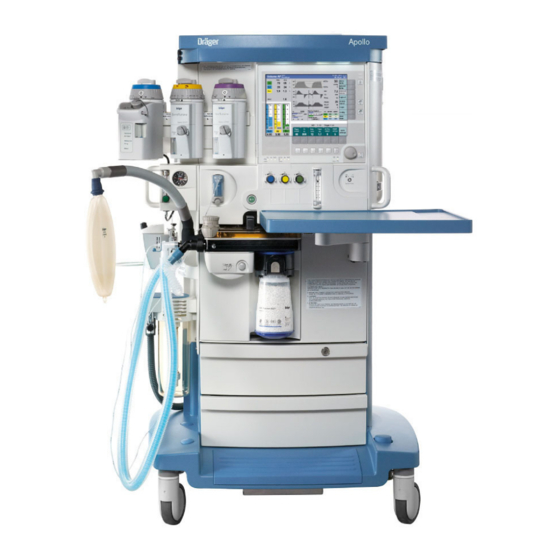
Table of Contents
Advertisement
Quick Links
Drägerwerk AG & Co. KGaA, 23542 Lübeck
To Dräger Customers and
Health Care Professionals
in the United States of America
COVID-19: Usage of Dräger anesthesia devices for long-term ventilation
Dear Customers and Health Care Professionals,
The World Health Organization (WHO) declared COVID-19 a pandemic on March 11
over 2,600,000 confirmed cases of the coronavirus illness reported in over 180 countries worldwide. The
pandemic has created a high demand for mechanical ventilation that may exceed the number of available ICU
ventilators in hospitals treating patients with the disease. In the last few days, many customers and health care
professionals have approached us to obtain information about possibly using Dräger anesthesia devices for
long-term ventilation as an alternative ventilator for ICU patients when existing devices are fully utilized and
there is no other ventilator option.
Drägerwerk AG & Co. KGaA
Bank details:
Moislinger Allee 53-55
Commerzbank AG, Lübeck
23558 Lübeck, Germany
IBAN: DE95 2304 0022 0014 6795 00
Swift-Code: COBA DE FF 230
Postal address:
Sparkasse zu Lübeck
23542 Lübeck, Germany
IBAN: DE15 2305 0101 0001 0711 17
Tel +49 451 882-0
Swift-Code: NOLADE21SPL
Fax +49 451 882-2080
info@draeger.com
www.draeger.com
Please visit the Dräger COVID-19 website
https://www.draeger.com/en-
us_us/Home/novel-coronavirus-outbreak
for updates and other useful information
Registered office: Lübeck
Commercial register:
Local court Lübeck HRB 7903 HL
General partner: Drägerwerk Verwaltungs AG
Registered office: Lübeck
Commercial register:
Local court Lübeck HRB 7395 HL
Our reference
COVID-19 – Draeger, Inc
Phone
1-800-4-DRAGER
E-mail
remosaus
@draeger.com
April 24
th
, 2020 with currently
Chairman of the Supervisory Board
for Drägerwerk AG & Co. KGaA and
Drägerwerk Verwaltungs AG:
Stefan Lauer
Executive Board:
Stefan Dräger (chairman)
Rainer Klug
Gert-Hartwig Lescow
Dr. Reiner Piske
Anton Schrofner
th
2020
Rev. 5
Advertisement
Table of Contents

Summarization of Contents
Legal and Regulatory Perspective on Off-Label Use
Understanding Intended Use vs. Off-Label Use
Differentiates intended use from off-label use of anesthesia devices.
Risk-Benefit Assessment for Off-Label Use
Discusses weighing benefits against risks for off-label device application.
EU Legal Perspective and General Guidance
Information limited to EU laws and provides general guidance.
Known Limitations for Long-Term Ventilation
1. General Instructions
Proposals to ensure safety and maintain ventilation capacity during off-label use.
2. Prerequisites & Preparation
Covers essential steps before using devices for extended periods.
Training of Medical Personnel
Emphasizes the need for personnel trained on anesthesia device specifics.
Location Requirements for Device Use
Specifies suitable environments and security measures for device operation.
Manual Resuscitator Availability
Mandates availability of manual resuscitators for backup ventilation.
Oxygen Backup Cylinder Requirement
Highlights the necessity of backup oxygen cylinders for continuous ventilation.
Gas Evacuation and Scavenging
Recommends proper scavenging to prevent oxygen accumulation.
Vaporizer and N2O Disconnection
Advises disconnecting vaporizers and N2O to avoid anesthetic agent risks.
Infection Prevention Measures
Stresses adherence to hospital guidelines and proper filter use.
Filters and Humidification Guidelines
Details suitable filters and considerations for humidification during long-term use.
Breathing Bag Function and Capacity
Explains the breathing bag's role and the importance of adequate capacity.
Water Trap (Waterlock 2) Maintenance
Outlines the function of the water trap and its maintenance requirements.
CO2 Absorber Management
Covers the importance of CO2 absorber examination and timely replacement.
System Configuration and Default Settings
Guides on adapting device settings for optimal long-term ventilation.
3. Regular Checks
Covers essential checks to ensure device readiness and proper functioning.
System Test Procedure
Details the procedure and frequency for system testing to ensure readiness.
System Restart and Memory Refresh
Recommends periodic system restarts to refresh internal memory components.
Overall Status and Accessory Checks
Emphasizes regular checks of device and accessory status to prevent issues.
4. Therapy
Provides guidance on therapy parameters and operational modes.
Fresh Gas Flow Management
Covers recommendations for high, additional, and reduced fresh gas flows.
Handling Leakages During Ventilation
Addresses how anesthesia devices handle leakages and their implications.
Understanding Ventilation Modes
Details available modes and differences from ICU ventilators.
Alarm Volume and Distribution
Sets alarm volume to 100% and discusses limitations of serial interface alarms.
Patient-Specific Alarm Limits
Guides on setting patient-specific alarm limits for critical parameters.
Alarm Notification Behavior
Describes how alarm notifications are cleared and the need to check history.
Gas Measurement and FiO2 Monitoring
Explains gas measurement delay and the importance of FiO2 monitoring.
Endotracheal Suctioning Procedures
Warns about negative pressures during suctioning and how to mitigate risks.
Nebulization and Aerosol Therapy
States that nebulization and aerosol therapy are not approved and may cause malfunctions.
Handling Device Failures
Instructs on immediate actions in case of a main component failure.
5. Consumption of Fresh Gas and Soda Lime
Details gas consumption based on fresh gas flow settings and ventilator type.
6. Oxygen Concentrator "O2 93"
Discusses the use of oxygen concentrators with anesthesia devices during shortages.
7. Direct Injection of Volatile Agents at Y-Piece (Not Recommended)
States that direct injection systems are not approved for use with these devices.
8. Ventilating Multiple Patients with One Device (Not Recommended)
Advises against ventilating multiple patients with a single device.
Document Attachments and References
Attachment 1: Comments on Particular Modes of Operation
Provides detailed explanations and comparisons of various ventilation modes.
Attachment 2: Overview of Ventilation Modes
Lists and compares ventilation modes across different Dräger device families.
Attachment 3: Dräger Fabius Family with Installed Fresh Gas Outlet (FGO)
Illustrates FGO variants and proper installation procedures for Fabius devices.
Attachment 4: Active Gas Scavenging (AGS) Alternatives
Discusses the importance and alternatives for active gas scavenging.
Attachment 5: Increasing Fresh Gas Flow
Describes how to increase fresh gas flow using the emergency O2 flow control.
Attachment 6: Fresh Gas Settings
Provides tables and examples for setting fresh gas flow and O2 concentration.
Attachment 7: Decision Support in Case of Supply Shortages
Offers guidance and decision trees for managing supply shortages.















Need help?
Do you have a question about the Apollo Series and is the answer not in the manual?
Questions and answers